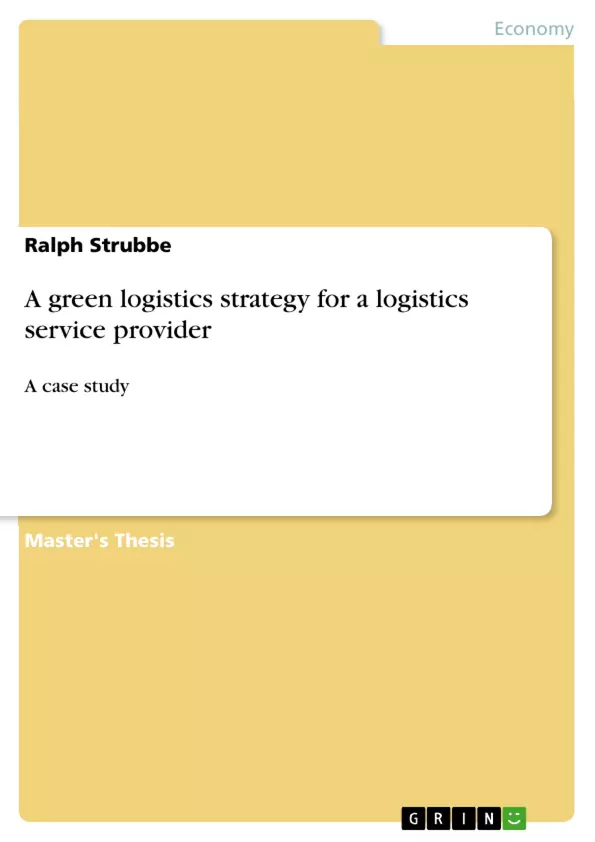With climate change and global warming being indisputable the world, its people, economy and companies face severe consequences. These can be literally natural disasters, ambitious climate protection goals and tightened environmental legislation for companies. As freight transport is responsible for a significant proportion of man made CO2 emissions it needs to contribute heavily to accomplishing Kyoto Protocol CO2 reduction targets. Besides complying with legislation focusing on sustainable development of logistics can yield further advantages such as cost savings and enhanced reputation.
This dissertation is about developing a green logistics strategy for Strubbe as a logistics service provider mainly concerned with freight transport. In terms of freight transport considering green strategies means focusing on managing carbon emissions. As managing without measuring is not possible the first step was calculating Strubbe´s carbon footprint. The energy-based calculation approach revealed TTW emissions of 1,120.39 tonnes CO2e for 2012, equivalent to 0.057 kg CO2e per tkm. Even though this intensity figure is lower than default values it could still be reduced by applying carbon emission reduction measures. These measures needed to be applicable to a freight transport concerned small logistics service provider like Strubbe. The review of potential measures yielded five practically applicable options: use of biodiesel (36.27%), reduction of maximum speed to 80 km/h (2.33%), vertical collaboration (1.88%), aerodynamic profiling (1.7%) and reduction of engine idling (0.41%). Their resprective percentage carbon abatement potentials are displayed in brackets. Further analysis revealed following changes in operating cost, in other words abatement costs: use of biodiesel (+19.24%), reduction of maximum speed to 80 km/h (+3.33%), vertical collaboration (-1.88%), aerodynamic profiling (+0.05%), reduction of engine idling (-0.41%).
Due to the highly competitive freight transport market it is recommended that the affected companies strive for weak sustainable development of their operations. Any increase of operating cost should be avoided. Thus only carbon reduction measures which decrease operating cost should be applied. Strubbe should implement all of the reviewed measures except the use of biodiesel.
Inhaltsverzeichnis (Table of Contents)
- CHAPTER: INTRODUCTION
- Research aim and objectives
- Scope of dissertation
- Outline of dissertation
- CHAPTER: LITERATURE REVIEW
- Introduction
- Supply chain management, logistics and freight transport
- Externalities from freight transport
- Corporate strategy alignment
- Carbon management
- Defining organisational boundaries
- Defining operational boundaries
- Carbon measuring and calculation approach and data collection
- Choice of conversion factors and calculation of footprint
- Carbon reduction measures
- Evaluation of measures
- Summary
- CHAPTER: METHODOLOGY
- Introduction
- Statement of values
- Research philosophy
- Research type
- Research approach
- Research strategy
- Data collection
- Data analysis
- Research quality
- Summary
- CHAPTER: CASE STUDY
- Introduction and case study description
- SMEs and the German road freight market
- Outline of the company and its activities
- Carbon footprinting
- Definition of boundaries
- Calculation approach
- Conversion factors
- Calculation and results
- Carbon reduction measures
- Improving vehicle utilisation
- Optimising the routing of vehicles
- Improving fuel efficiency
- Alternative fuels
- Evaluation of carbon reduction measures
Zielsetzung und Themenschwerpunkte (Objectives and Key Themes)
This dissertation investigates the development of a green logistics strategy for a logistics service provider focusing on freight transport. The main objective is to determine the carbon footprint of the company and identify practical carbon emission reduction measures that are applicable to a small logistics service provider.
- Carbon footprint analysis
- Carbon emission reduction measures
- Evaluation of measures based on cost-effectiveness
- Sustainable development in the context of freight transport
- Implementation of a green logistics strategy
Zusammenfassung der Kapitel (Chapter Summaries)
The first chapter introduces the research aim and objectives of the dissertation, outlining its scope and structure. Chapter two provides a comprehensive literature review on relevant topics such as supply chain management, logistics, freight transport, externalities, corporate strategy alignment, and carbon management. It explores various aspects of carbon management, including defining organisational and operational boundaries, carbon measuring and calculation approaches, data collection, conversion factors, carbon reduction measures, and evaluation of measures. Chapter three delves into the methodology employed in the research, outlining the statement of values, research philosophy, type, approach, strategy, data collection and analysis, as well as research quality. Chapter four focuses on the case study of Strubbe, a small logistics service provider. It introduces the company's activities and the German road freight market, and then proceeds to calculate the company's carbon footprint. The chapter also examines various carbon reduction measures and their evaluation, considering their potential for reducing emissions and their implications for operating costs.
Schlüsselwörter (Keywords)
Green logistics, freight transport, carbon footprint, carbon reduction measures, sustainable development, cost-effectiveness, logistics service provider, SMEs, German road freight market.
- Quote paper
- Ralph Strubbe (Author), 2013, A green logistics strategy for a logistics service provider, Munich, GRIN Verlag, https://www.grin.com/document/340339



